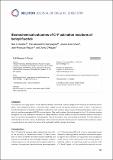Stereochemical outcomes of C-F activation reactions of benzyl fluoride
Abstract
In recent years, the highly polar C-F bond has been utilised in activation chemistry despite its low reactivity to traditional nucleophiles, when compared to other C-X halogen bonds. Paquin's group has reported extensive studies on the C-F activation of benzylic fluorides for nucleophilic substitutions and Friedel-Crafts reactions, using a range of hydrogen bond donors such as water, triols or hexafluoroisopropanol (HFIP) as the activators. This study examines the stereointegrity of the C-F activation reaction through the use of an enantiopure isotopomer of benzyl fluoride to identify whether the reaction conditions favour a dissociative (SN1) or associative (SN2) pathway. [2H]-Isotopomer ratios in the reactions were assayed using the Courtieu 2H NMR method in a chiral liquid crystal (poly-γ-benzyl-L-glutamate) matrix and demonstrated that both associative and dissociative pathways operate to varying degrees, according to the nature of the nucleophile and the hydrogen bond donor.
Citation
Keddie , N S , Champagne , P A , Desroches , J , Paquin , J-F & O'Hagan , D 2018 , ' Stereochemical outcomes of C-F activation reactions of benzyl fluoride ' , Beilstein Journal of Organic Chemistry , vol. 14 , pp. 106-113 . https://doi.org/10.3762/bjoc.14.6
Publication
Beilstein Journal of Organic Chemistry
Status
Peer reviewed
ISSN
1860-5397Type
Journal article
Description
NK and DOH acknowledge support from the University of St Andrews, Engineering and Physical Sciences Research Council (EPSRC, Grant No.: EP/L017911/1), and the EPSRC UK National Mass Spectrometry Facility at Swansea University. This work was also supported by the Natural Sciences and Engineering Research Council of Canada (NSERC), the FRQNT Centre in Green Chemistry and Catalysis (CGCC), and the Université Laval.Collections
Items in the St Andrews Research Repository are protected by copyright, with all rights reserved, unless otherwise indicated.

